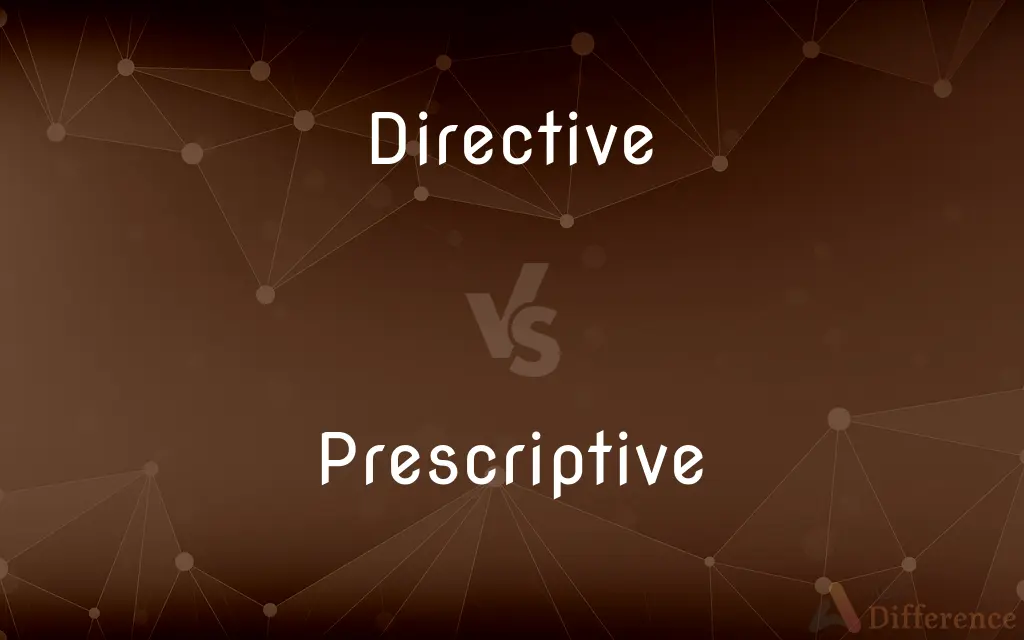Directive vs. Prescriptive — What's the Difference?
By Fiza Rafique & Maham Liaqat — Updated on March 21, 2024
A directive provides instructions or guidance on actions to be taken, while prescriptive outlines specific rules or standards that must be followed.

Difference Between Directive and Prescriptive
Table of Contents
ADVERTISEMENT
Key Differences
A directive is an authoritative instruction or guideline meant to guide actions or conduct, often issued by an organization or authority figure. It suggests a course of action but might allow for some flexibility in its implementation. On the other hand, prescriptive implies a more rigid set of rules or recommendations that specify exactly how something should be done, leaving little to no room for deviation.
Directives are often used in organizational or administrative contexts to steer processes or behaviors towards desired outcomes, providing a framework within which individuals can operate. Prescriptive guidelines, however, are typically found in contexts where consistency and adherence to established norms or standards are critical, such as in language usage, laws, or technical specifications.
While a directive might suggest best practices or preferred procedures, a prescriptive approach dictates specific methodologies, tools, or practices that must be employed, often to ensure uniformity, safety, or compliance. For example, a company might issue a directive for employees to use secure passwords, while a prescriptive rule would specify the exact requirements for the password, such as length and character types.
In essence, the key difference lies in the level of discretion allowed: directives provide guidance with some leeway for personal judgment, whereas prescriptive rules set forth explicit standards with expected compliance.
Comparison Chart
Definition
Instructions or guidelines suggesting actions to be taken.
Specific rules or standards detailing how actions must be performed.
ADVERTISEMENT
Flexibility
Allows some discretion in implementation.
Little to no room for deviation from the specified rules.
Context
Organizational, administrative, guiding processes or behaviors.
Contexts requiring consistency, safety, or adherence to norms.
Purpose
To guide towards desired outcomes within a flexible framework.
To ensure uniformity, compliance, or adherence to strict standards.
Examples
Organizational policies, strategic directives.
Language rules, legal regulations, technical specifications.
Compare with Definitions
Directive
A formal communication that directs how tasks should be approached.
The safety directive emphasized the importance of wearing protective gear.
Prescriptive
Stipulating exact rules or specifications that must be followed.
The prescriptive standards for medical equipment ensure patient safety.
Directive
An authoritative instruction guiding action or behavior.
The manager's directive was to improve team efficiency without micromanaging.
Prescriptive
Establishing fixed rules or methods to be applied.
The prescriptive approach to software development required strict adherence to the designated process.
Directive
A policy or statement that guides actions in a particular domain.
The government's environmental directive focused on reducing emissions.
Prescriptive
Involving the imposition of rules or directions.
The regulatory framework was prescriptive in its requirements for financial reporting.
Directive
An order or command from a higher authority.
The executive's directive was to pivot the project's direction based on market research.
Prescriptive
Setting out detailed requirements or procedures.
The language guide was prescriptive about the use of certain grammatical structures.
Directive
A guideline meant to influence decision-making or actions.
The directive on data privacy outlined steps to protect user information.
Prescriptive
Dictating a specific course of action with no allowance for deviation.
The building codes were prescriptive in terms of materials and construction methods.
Directive
An official or authoritative instruction
A new EC directive
Prescriptive
Relating to or making rules, laws, or directions
Prescriptive pronouncements.
Directive
Involving the management or guidance of operations
The authority is seeking a directive role in energy policy
Prescriptive
(Linguistics) Based on or establishing norms or rules indicating how a language should or should not be used rather than describing the ways in which a language is used.
Directive
An order or instruction, especially one issued by an authority.
Prescriptive
(Law) Of or relating to acquisition or occupancy by prescription.
Directive
Serving to direct, indicate, or guide.
Prescriptive
(Archaic) Sanctioned or authorized by long-standing custom or usage.
Directive
That which directs; serving to direct, indicate, or guide.
Prescriptive
Of or pertaining to prescribing or enjoining, especially an action or behavior based on a norm or standard.
Directive
(grammar) Relating to the directive case.
Prescriptive
Consisting in, or acquired by, immemorial or long-continued use and enjoyment; as, a prescriptive right of title; pleading the continuance and authority of long custom.
The right to be drowsy in protracted toil has become prescriptive.
Directive
An instruction or guideline that indicates how to perform an action or reach a goal.
Prescriptive
Of or pertaining to the doctrine that acceptable grammatical rules should be prescribed by authority, rather than be determined by common usage.
Directive
(programming) A construct in source code that indicates how it should be processed but is not necessarily part of the program to be run.
Prescriptive
Giving directives or rules;
Prescriptive grammar is concerned with norms of or rules for correct usage
Directive
An authoritative decision from an official body, which may or may not have binding force.
Directive
(European Union law) A form of legislative act addressed to the member states. The directive binds the member state to reach certain objectives in their national legislation.
Directive
(grammar) The directive case.
Directive
Having power to direct; tending to direct, guide, or govern; showing the way.
The precepts directive of our practice in relation to God.
Directive
Able to be directed; manageable.
Swords and bowsDirective by the limbs.
Directive
A pronouncement encouraging or banning some activity;
The boss loves to send us directives
Directive
Showing the way by conducting or leading; imposing direction on;
Felt his mother's directing arm around him
The directional role of science on industrial progress
Common Curiosities
How do organizations benefit from using directives?
Organizations benefit from directives by providing direction and guiding behavior while allowing for flexibility and adaptation to specific circumstances.
Can a directive evolve into a prescriptive rule?
Yes, a directive can evolve into a prescriptive rule if it becomes necessary to standardize actions more rigidly to achieve desired outcomes or ensure compliance.
Why might a prescriptive approach be necessary?
A prescriptive approach might be necessary in contexts where uniformity, safety, compliance, or consistency is critical, such as in healthcare, aviation, or engineering.
Can a directive be prescriptive?
While a directive can be prescriptive if it specifies exact actions without room for discretion, typically directives allow for more flexibility than prescriptive rules.
How does the flexibility of a directive affect its implementation?
The flexibility of a directive can lead to varied implementations, allowing individuals or teams to adapt the guidance to their specific context or needs.
Are prescriptive rules more common in certain fields?
Yes, prescriptive rules are more common in fields that require high levels of precision, safety, and consistency, such as law, medicine, and engineering.
Do cultural norms influence the directive or prescriptive nature of guidance?
Yes, cultural norms can influence whether guidance is more directive or prescriptive, with some cultures favoring clear rules and others valuing autonomy and discretion.
Is a prescriptive approach to language usage generally accepted?
Prescriptive language rules are often debated within linguistic communities, with some advocating for strict adherence and others for descriptive approaches that observe language use.
How do professionals navigate between directive and prescriptive guidance in their work?
Professionals navigate between the two by understanding the context, objectives, and the degree of flexibility or compliance required in their tasks.
Are prescriptive guidelines always legal requirements?
Prescriptive guidelines are not always legal requirements; they can also include technical standards, grammatical rules, or other forms of strict guidelines.
What role does leadership play in setting directives and prescriptive rules?
Leadership plays a crucial role in setting the tone and expectations, choosing between directive guidance and prescriptive rules based on goals, values, and organizational culture.
How can ambiguity in directives be addressed to ensure clarity?
Ambiguity in directives can be addressed by providing clear objectives, examples, and, if necessary, boundaries within which discretion is allowed.
Can the prescriptive nature of a rule be a disadvantage?
The prescriptive nature of a rule can be a disadvantage if it stifles creativity, innovation, or adaptation to unique situations or needs.
How do employees typically respond to directives vs. prescriptive rules?
Employees might respond more favorably to directives as they offer more autonomy, whereas prescriptive rules might be viewed as more restrictive.
Can a prescriptive rule be changed or modified?
Prescriptive rules can be changed or modified, but this typically involves formal processes or revisions by the governing or authoritative bodies.
Share Your Discovery

Previous Comparison
Brilliant vs. Ingenious
Next Comparison
Decagon vs. DecahedronAuthor Spotlight
Written by
Fiza RafiqueFiza Rafique is a skilled content writer at AskDifference.com, where she meticulously refines and enhances written pieces. Drawing from her vast editorial expertise, Fiza ensures clarity, accuracy, and precision in every article. Passionate about language, she continually seeks to elevate the quality of content for readers worldwide.
Co-written by
Maham Liaqat















































